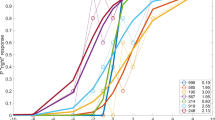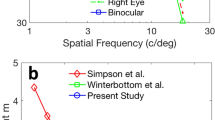Summary
We have studied visual evoked potentials (VEP) in the cat using dichoptically presented sinusoidal gratings. Our goals were to determine if binocular disparity causes differential responses in the VEP, and to examine the effects of monocular deprivation and convergent or divergent strabismus on the degree of binocular summation. Binocular disparity in stimuli causes no regular alterations of visual evoked responses, except at very low spatial frequencies. However, this apparent selectivity is probably due to luminance modulation in the central retina at low frequencies. The insensitivity to binocular disparity establishes that binocular summation in the VEP may be estimated without regard to the relative phase of gratings presented to the two eyes. Binocular summation of the VEP was examined in normal animals. We found that the ratio of the binocularly evoked response to the largest monocular response (averaged across spatial frequency) ranged from 1.27 to 2.12 (4 animals) and had a mean of 1.48. These values fall within the range which has been reported for human subjects. The degree of summation might be expected to be greatly reduced in strabismic and monocularly deprived animals, in which the majority of the cells are functionally monocular. While summation was found to be reduced in 5 esotropic (convergent) animals (range = 1.13–1.24; mean = 1.18) it was approximately normal in three exotropic (divergent) animals (range = 1.29–2.12; mean = 1.61). However, single unit recordings carried out on the same animals show similar reductions of cells that can be driven through either eye for both groups of animals. Recordings from three monocularly deprived animals, on the other hand, show evidence of binocular interaction in the form of suppression. In this case, response amplitudes obtained using binocular stimulation were consistently and substantially smaller than those obtained from the normal eye alone (range = 0.76–0.85; mean = 0.80). We conclude that convergent and divergent strabismus differ substantially in the degree to which binocular summation is exhibited in the VEP, which in the latter condition, is indistinguishable from the normal cat. Monocular deprivation causes an effect which is markedly different from either form of strabismus in that the deprived eye suppresses the response of the normal eye.
Similar content being viewed by others
References
Amigo G, Fiorentini A, Pirchio M, Spinelli D (1978) Binocular vision tested with evoked potentials in children and infants. Invest Ophthal Vis Sci 17: 910–915
Anninos PA, Zenone S, Cyrulnik RA, Elul R (1982) Encoding of visual information: correlation of EEG response to intracellular response. Brain Res 244: 182–185
Blakemore C, Hague B (1972) Evidence for disparity detecting neurones in the human visual system. J Physiol (London) 225: 437–455
Bonds AB, Freeman RD, Sclar G (1980) A comparison of singleunit and visually evoked potentials in monocularly deprived cats. J Physiol (London) 306: 28–29P
Campbell FW, Maffei L (1970) Electrophysiological evidence for the existence of orientation and size detectors in the human visual system, J Physiol (London) 207: 635–652
Creutzfeldt OD, Rosina A, Ito M, Probst W (1969) Visual evoked response of single cells and of the EEG in primary area of the cat. J Neurophysiol 32: 127–139
Ferster D (1981) A comparison of binocular depth mechanisms in areas 17 and 18 of the cat visual cortex. J Physiol (London) 311: 623–655
Fiorentini A, Maffei L (1970) Electrophysiological evidence for binocular disparity detectors in human visual system. Science 169: 208–209
Fiorentini A, Maffei L, Pirchio M, Spinelli D (1978) An electrophysiological correlate of perceptual suppression in anisometropia. Vision Res 18: 1617–1621
Freeman RD, Ohzawa I (1983) Binocular interaction in cortical cells of monocularly deprived kittens. Soc Neurosci Abstr 9: part-2, p 912
Freeman RD, Robson JG (1982) A new approach to the study of binocular interaction in visual cortex: normal and monocularly deprived cats. Exp Brain Res 48: 296–300
Freeman RD, Sclar G, Ohzawa I (1983) An electrophysiological comparison of convergent and divergent strabismus in the cat: visual evoked potentials. J Neurophysiol 49: 227–237
Freeman RD, Sclar G, Ohzawa I (1983) A quantitative comparison of binocular and monocular cells in the visual cortex of strabismic cats. Invest Ophthal. Visual Sci 24: 140 (Suppl)
Freeman RD, Tsumoto T (1983) An electrophysiological comparison of convergent and divergent strabismus in cats: electrical and visual activation of single cortical cells. J Neurophysiol 49: 238–253
Grünau M von (1979) Binocular summation and the binocularity of cat visual cortex. Vision Res 19: 813–816
Hammond P, Mackay DM (1977) Differential responsiveness of simple and complex cells in cat striate cortex to visual texture. Exp Brain Res 30: 275–296
Hubel DH, Wiesel TN (1962) Receptive fields, binocular interaction and functional architecture in the cat's visual cortex. J Physiol (London) 160: 106–154
Julesz B (1971) Foundations of Cyclopean Perception. Univ. of Chicago Press, Publ Chicago IL
Julesz B, Kropfl W, Petrig B (1978) Large, cortically evoked potentials elicited by random-dot stereograms and correlograms. J Opt Soc Am 68: 1420
Julesz B, Kropfl W, Petrig B (1980) Large evoked potentials to dynamic random-dot correlograms and stereograms permit the quick determination of stereopsis. Proc Nat Acad Sci USA 77: 2348–2351
Kalil RE, Spear PD, Langsetmo A (1980) Response properties of striate cortex neurons in cats raised with divergent or convergent strabismus. J Neurophysiol 52: 514–537
Lehmann D, Julesz B (1978) Lateralized cortical potentials evoked in humans by dynamic random-dot stereograms. Vision Res 18: 1265–1271
Lehmann D, Skrandies W, Lindermaier C (1978) Sustained cortical potentials evoked in humans by binocularly correlated, uncorrelated and disparate dynamic random-dot stimuli. Neurosci Lett 10: 129–134
Miezin FM, Myerson J, Julesz B, Allman JM (1981) Evoked potentials to dynamic random-dot correlograms in monkey and man: a test for cyclopean perception. Vision Res 21: 177–179
Ohzawa I, Freeman RD (1984) Mechanisms underlying binocular interactions of cells in the cat's visual cortex. Soc Neurosci Abstr 10: part-1, p 472
Regan D, Spekreijse H (1970) Electrophysiological correlate of binocular depth perception in man. Nature (London) 225: 92–94
Rodieck RW, Pettigrew JD, Bishop PO, Nikara T (1967) Residual eye movements in receptive-field studies of paralyzed cats. Vision Res 7: 107–110
Sherman SM, Spear PD (1982) Organization of visual pathways in normal and visually deprived cats. Physiol Rev 62: 738–855
Snyder A, Shapley RM (1979) Deficits in the visual evoked potentials of cats as a result of visual deprivation. Exp Brain Res 37: 73–86
Srebro R (1978) The visually evoked response. Arch Ophthalmol 96: 839–844
White CT, Bonelli L (1970) Binocular summation in the evoked potential as a function of image quality. Am J Optom 47: 304–309
Young W (1981) The interpretation of surface recorded evoked potentials. Trends Neurosci 4: 27–280
Author information
Authors and Affiliations
Rights and permissions
About this article
Cite this article
Sclar, G., Ohzawa, I. & Freeman, R.D. Binocular summation in normal, monocularly deprived, and strabismic cats: visual evoked potentials. Exp Brain Res 62, 1–10 (1986). https://doi.org/10.1007/BF00237398
Received:
Accepted:
Issue Date:
DOI: https://doi.org/10.1007/BF00237398




